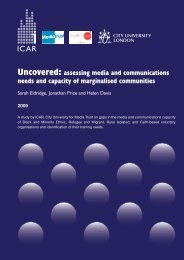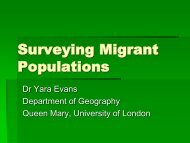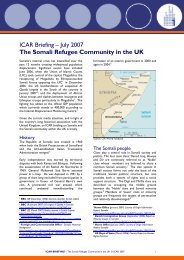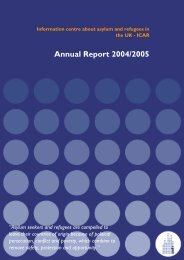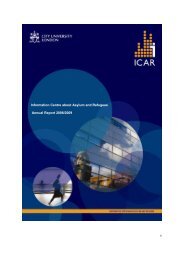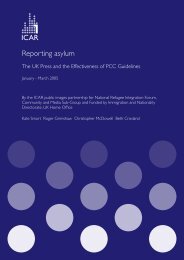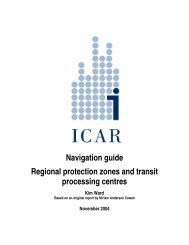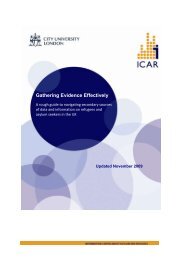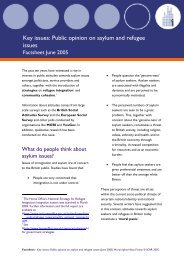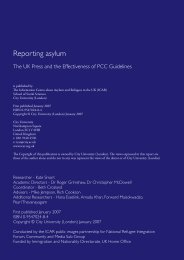The Somali community in the UK: What we know and how we ... - ICAR
The Somali community in the UK: What we know and how we ... - ICAR
The Somali community in the UK: What we know and how we ... - ICAR
Create successful ePaper yourself
Turn your PDF publications into a flip-book with our unique Google optimized e-Paper software.
purposes. <strong>The</strong> same might be said of <strong>the</strong> map<br />
reproduced above which could be taken to<br />
re<strong>in</strong>force <strong>the</strong> notion that clans are tied to territory.<br />
Orig<strong>in</strong>ally <strong>the</strong> relationship to l<strong>and</strong> was fluid - it is<br />
often said about <strong>Somali</strong>s that it is not where you<br />
start with an explanation of its role <strong>in</strong> <strong>the</strong> country<br />
of orig<strong>in</strong>. 150<br />
A clan-based form of social structure is familiar<br />
from o<strong>the</strong>r African pastoral societies <strong>in</strong> which<br />
k<strong>in</strong>ship forms <strong>the</strong> basis of social, political, <strong>and</strong><br />
are from which is significant, but whom; family not<br />
place of birth. Clan overlaps with region, but it is<br />
genealogy not geography that determ<strong>in</strong>es alliances.<br />
Ho<strong>we</strong>ver, one of <strong>the</strong> effects of Barre’s regime was<br />
to tighten <strong>the</strong> territorial connection, so as conflict<br />
does arise over l<strong>and</strong>, such schematic statements<br />
could exacerbate claims to terra<strong>in</strong>. <strong>The</strong> map is<br />
<strong>in</strong>cluded here to s<strong>how</strong> <strong>the</strong> rough geography of clan,<br />
which has been politically significant (<strong>and</strong> also to<br />
<strong>in</strong>dicate <strong>the</strong> extent of territory <strong>in</strong>habited by <strong>Somali</strong><br />
speakers of various groups which lies outside <strong>the</strong><br />
national boundaries <strong>and</strong> has been <strong>the</strong> focus of<br />
extended conflict). Although a difficult topic, <strong>the</strong><br />
question of clan has to be confronted <strong>in</strong><br />
any discussion of <strong>Somali</strong>s <strong>in</strong> <strong>the</strong> diaspora, <strong>and</strong> must<br />
economic life. A common term for this type of<br />
organisation is ‘segmentary’, as each clan family can<br />
be broken down <strong>in</strong>to its constituent segments of<br />
clan, which <strong>in</strong> turn divide <strong>in</strong>to subclans, l<strong>in</strong>eages,<br />
<strong>and</strong>, at <strong>the</strong> bottom of <strong>the</strong> pyramid, <strong>the</strong> extended<br />
family <strong>and</strong> f<strong>in</strong>ally <strong>the</strong> household. Each unit bases<br />
its identity on <strong>the</strong> claim - albeit mythic - to be<br />
descended from a common male ancestor. Women,<br />
even after marriage, rema<strong>in</strong> members of <strong>the</strong>ir<br />
natal l<strong>in</strong>eage, but descent is not traced through <strong>the</strong><br />
female l<strong>in</strong>e. <strong>The</strong> lo<strong>we</strong>st level of k<strong>in</strong> group which<br />
is politically significant is <strong>the</strong> diya-pay<strong>in</strong>g group<br />
(<strong>the</strong> k<strong>in</strong>ship unit responsible for settl<strong>in</strong>g blood<br />
feuds), whose members will be able to trace <strong>the</strong>ir<br />
ancestry back some four to eight generations.<br />
145. Home Office circular 10/2004, available at http://www.homeoffice.gov.uk/docs3/hoc1004.html.<br />
146. <strong>The</strong>re are several o<strong>the</strong>r organisations both <strong>in</strong> London <strong>and</strong> round <strong>the</strong><br />
country dedicated both to education <strong>and</strong> personal support on FGM, such as<br />
<strong>the</strong> Agency for Culture <strong>and</strong> Change Management <strong>in</strong> Sheffield.<br />
147. <strong>The</strong> CD-ROM also <strong>in</strong>cludes sections on <strong>the</strong> history of To<strong>we</strong>r Hamlets<br />
<strong>and</strong> <strong>the</strong> <strong>Somali</strong> <strong>community</strong> besides <strong>in</strong>formation on BWHAFS <strong>and</strong> on FGM,<br />
with bibliography. It is obta<strong>in</strong>able from BWHAFS, 1st Floor, 82 Russia Lane,<br />
London E2 9LU.<br />
148. Sources for this section <strong>in</strong>clude: Abdullahi (2001); Griffiths (2002);<br />
Lewis (1999 [1961]); Samatar (1988); Stevenson (1995).<br />
149. As reproduced on <strong>we</strong>bsite: http://www.lib.utexas.edu/maps/africa/somalia-_ethnic_grps_2002.jpg.<br />
150. Griffith’s analysis of <strong>the</strong> significance of clan <strong>in</strong> <strong>the</strong> <strong>Somali</strong> <strong>community</strong><br />
(2002: 94-127) is prefaced with an historical account (ibid: 27-46).<br />
<strong>The</strong> <strong>Somali</strong> <strong>community</strong> <strong>in</strong> <strong>the</strong> <strong>UK</strong><br />
67





